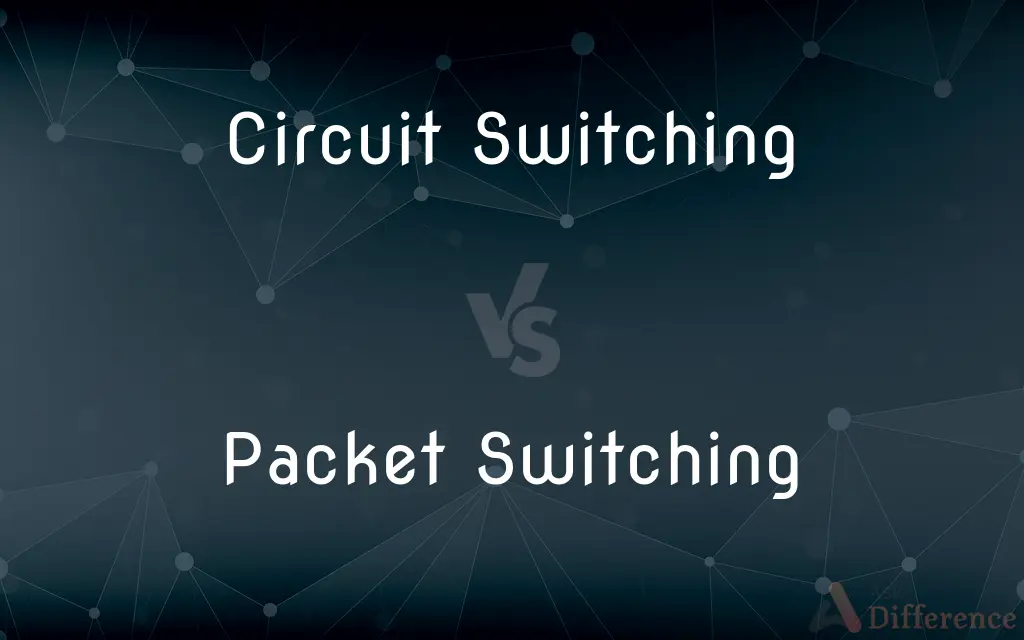Circuit Switching vs. Packet Switching — What's the Difference?
By Tayyaba Rehman — Published on January 9, 2024
Circuit Switching establishes a dedicated communication path between nodes. Packet Switching divides data into packets, sending each independently over the network.

Difference Between Circuit Switching and Packet Switching
Table of Contents
ADVERTISEMENT
Key Differences
Circuit Switching: Circuit switching involves establishing a dedicated communication channel between two nodes for the duration of the communication session. This approach, used traditionally in telephone networks, ensures a constant transmission rate and path. Packet Switching: In contrast, packet switching divides data into packets, each of which can take different paths to reach the destination. This method is more efficient for data networks like the internet, where variable transmission rates are common.
Circuit Switching: A key characteristic of circuit switching is the need for a dedicated connection, which remains constant and exclusive throughout the communication. This leads to the inefficient use of resources when the dedicated line is not in active use. Packet Switching: Packet switching, on the other hand, allows for network resources to be shared among multiple users, as packets from different sources intermingle on the same network paths, leading to better resource utilization.
Circuit Switching: Circuit switching provides a predictable performance, as the dedicated path ensures consistent transmission quality, albeit at the cost of setup time for establishing the circuit. This makes it suitable for applications requiring steady data rates, like voice calls. Packet Switching: With packet switching, there’s no setup delay, but the performance can be less predictable due to varying packet routes and network congestion, making it ideal for bursty data traffic like web browsing and email.
Circuit Switching: In circuit switching, the failure of a node or link can disrupt the entire communication since the dedicated path is compromised. This lack of redundancy can lead to lower resilience in the face of network issues. Packet Switching: Packet switching offers higher resilience as packets can be rerouted through different paths in case of a node or link failure, enhancing the network's reliability and fault tolerance.
Circuit Switching: This approach is typically more straightforward but less flexible, as it does not adapt dynamically to changes in network conditions or traffic patterns. Packet Switching: Packet switching is inherently more complex due to the need for packet routing and reassembly but offers greater flexibility and adaptability to changing network conditions.
ADVERTISEMENT
Comparison Chart
Connection Type
Dedicated path for entire session
No dedicated path, data sent in packets
Resource Utilization
Inefficient, as resources reserved
Efficient, as resources shared
Setup Time
Requires initial setup time
No setup time, immediate transmission
Adaptability
Less adaptable to network changes
Highly adaptable, reroutes packets
Suitability
Ideal for steady, continuous data flow
Suitable for bursty, variable data flow
Compare with Definitions
Circuit Switching
This method provides consistent data transmission rate.
Circuit switching is used for real-time audio transmissions, guaranteeing steady sound quality.
Packet Switching
Packet switching allows multiple users to share network resources.
During peak internet usage, packet switching enables efficient data transfer by utilizing available network paths.
Circuit Switching
It’s less efficient for intermittent data transmission.
Despite its reliability, circuit switching is not ideal for internet browsing due to its continuous resource allocation.
Packet Switching
Packet switching divides data into packets for transmission.
Internet data is often sent using packet switching, allowing for efficient email and web page delivery.
Circuit Switching
Circuit switching reserves resources for each communication session.
A dedicated line in circuit switching ensures uninterrupted data flow during a video conference.
Packet Switching
This method is adaptable to changing network conditions.
If a router fails, packet switching reroutes data packets through an alternate path without interruption.
Circuit Switching
Circuit switching involves creating a dedicated communication path.
Traditional landline telephones use circuit switching to maintain a constant connection during calls.
Packet Switching
It’s ideal for bursty data transmission.
Packet switching is efficient for web browsing, where data is sent and received in bursts.
Circuit Switching
It is a network switching technique that establishes a static route.
In a circuit-switched network, a call from New York to London maintains the same path for its duration.
Packet Switching
It sends packets via the most efficient route available.
In packet switching, a video stream's packets may take different routes, depending on network congestion.
Common Curiosities
How does packet switching handle network congestion?
Packet switching manages network congestion by routing packets through less congested paths.
Can circuit switching adapt to sudden network changes?
Circuit switching is less flexible and cannot easily adapt to sudden changes in the network.
Is packet switching more efficient than circuit switching?
Packet switching is generally more efficient for data networks due to better resource utilization.
What happens if a circuit in circuit switching fails?
If a circuit fails in circuit switching, the entire communication session is disrupted.
What is circuit switching primarily used for?
Circuit switching is primarily used for traditional voice telephony and other real-time services.
Does circuit switching require a constant connection?
Yes, circuit switching requires a constant and dedicated connection between the communicating parties.
How do packet-switched networks handle large files?
Packet-switched networks divide large files into smaller packets, transmitting each independently.
How do packet-switched networks optimize data flow?
Packet-switched networks optimize data flow by dynamically routing packets based on network conditions.
What is a disadvantage of circuit switching?
A major disadvantage of circuit switching is the inefficient use of network resources during inactive periods.
Does packet switching guarantee a fixed transmission rate?
Packet switching does not guarantee a fixed transmission rate, as it varies with network traffic.
Why is circuit switching considered less flexible?
Circuit switching is less flexible due to its reliance on a pre-established, fixed path for communication.
Is circuit switching still used today?
Circuit switching is still used, particularly in traditional telephony and specialized applications.
Are circuit-switched networks less prone to data loss?
Circuit-switched networks are less prone to data loss for the duration of the dedicated connection.
Are packet-switched networks more complex?
Yes, packet-switched networks are more complex due to the need for dynamic routing and packet reassembly.
Can packet switching handle different types of data?
Yes, packet switching can handle various data types, making it versatile for internet and data applications.
Share Your Discovery

Previous Comparison
URL vs. Domain Name
Next Comparison
Revolutionary War vs. Civil WarAuthor Spotlight
Written by
Tayyaba RehmanTayyaba Rehman is a distinguished writer, currently serving as a primary contributor to askdifference.com. As a researcher in semantics and etymology, Tayyaba's passion for the complexity of languages and their distinctions has found a perfect home on the platform. Tayyaba delves into the intricacies of language, distinguishing between commonly confused words and phrases, thereby providing clarity for readers worldwide.
















































